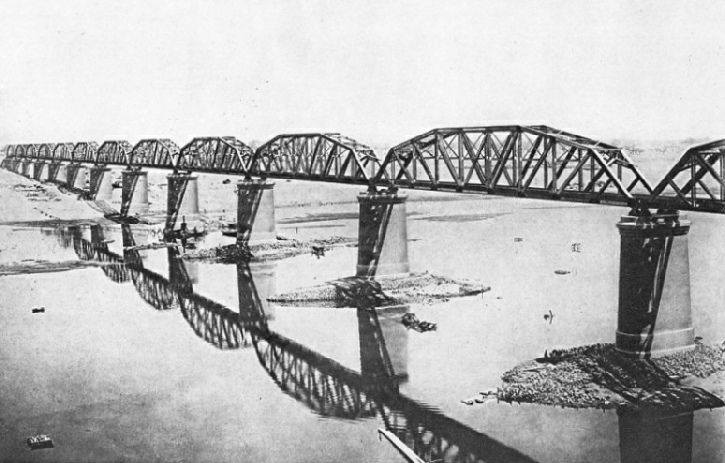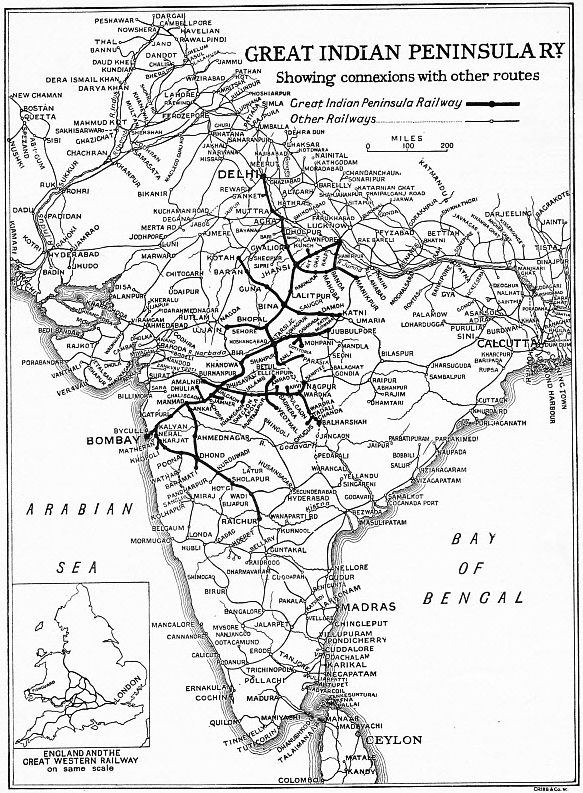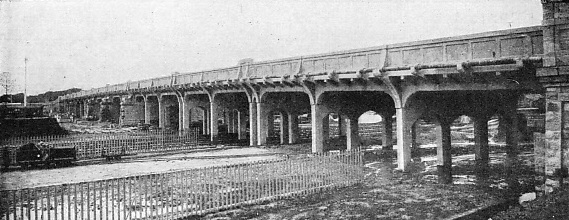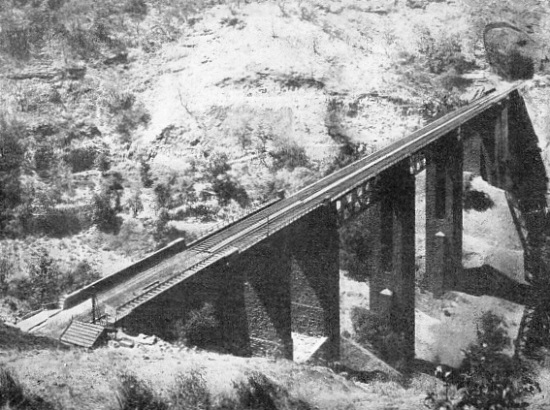
© Railway Wonders of the World 2024 | Contents | Site Map | Contact Us | Cookie Policy


The Railway Invasion of India - 1
How the distant coasts of the Indian peninsula were brought into inter-
RAILWAYS OF THE COMMONWEALTH -

HOW THE GREAT INDIAN PENINSULA RAILWAY CROSSES THE RIVER JUMNA BETWEEN CAWNPORE AND BANDA. This single track bridge is 3,516 feet in length, comprises twelve spans each of 250 feet, contains 4,968 tons of steel and cost £167,000.
DREAMERS of action, impressed with the wonderful revolution wrought by the locomotive upon the social and commercial life of Great Britain, conceived the idea of carrying the railway to further triumphs in other parts of the Empire. At that time -
What was the official attitude towards the railway? That was the crucial question. The destinies of the country were in the hands of the East India Company, the virility and enterprise of which had long since evaporated, while officialdom, as represented by the Governor-
Notwithstanding the apathetic, if not actually hostile, official attitude towards the innovation, dauntless pioneers decided to pursue their quest. They besieged the Honourable Court of Directors of the East India Company with applications for concessions, but in vain. So effectively were the wheels of progress braked that, by 1852, only some 200 miles of line had been sanctioned for construction, and there was not a mile in operation! In that year the avalanche of requests to enmesh the country attained such volume that the Court of Directors was induced to refer the whole issue to the then Governor-
The worthy members constituting the Honourable Court encountered a troublesome thorn in the person of one energetic citizen of London. This was John Chapman. He had conceived a scheme for planting the locomotive in India which he was determined to carry through at all hazards, and his pertinacity was certainly disturbing to the tranquil atmosphere of India House. He spent three solid years perusing all the records of the company to fortify himself with the correct procedure in his assault upon the official stronghold, and succeeded in rousing the enthusiasm of sufficient kindred spirits to found a provisional company. In August, 1845, he hurried to Bombay, accompanied by a civil engineer, G. T. Clark. Chapman and Clark, together with another civil engineer, Conybeare, who had been brought out to Bombay in connexion with a stillborn suburban railway, prospected the country for a route across the western half of the Peninsula to effect junction with an eastern line and thus provide a short overland cut between Bombay and Calcutta.

THE GREAT INDIAN PENINSULA RAILWAY AND ITS CONNEXIONS. It is the railway backbone of Central India with the home terminal at Bombay. Inset, by way of comparison, is a Great Western map of England on the same scale, with the trunk lines of the old Great Western Railway.
Upon his return home Chapman discovered the railway outlook to have undergone a dramatic change. In 1845 Britain was in the throes of the railway mania; Chapman, in common with other would-
This decision entirely upset the plans for the locomotive invasion of India. Railway construction would be impossible without official assistance. At this suggestion the directors of the East India Company were staggered, but they endeavoured to temporize with the offer of grants of land, which, needless to say, were received with contempt. The general situation was somewhat disturbing to Chapman and his colleagues, but he decided to push ahead. He launched his application to the Court of Directors, who, impressed by the mass of material he had gathered in its support, discreetly considered his proposal and discussed its details protractedly with him.
Chapman’s dogged determination and persistence brought its reward. On August 1, 1849, the Act was passed authorizing his scheme for the incorporation of the Great Indian Peninsula Railway Company, Limited, with a capital of £500,000, to build a line from Bombay to Kalyan, 34 miles, with the further right to increase the capital to £1,000,000 should it be decided to extend the road beyond the point named.
Some of the weighty recommendations accompanying this reluctantly-
Upon obtaining the charter the forces for construction were rapidly mobilized. Robert Stephenson was persuaded to accept the appointment of consulting engineer to the new undertaking, and continued to act in this capacity until his death in 1859, while another unsuspected engineering genius was discovered in Mr. James J. Berkley, who was appointed Chief Resident Engineer in charge of construction. He reached Bombay on February 7, 1850, and within a short while had his surveyors in the field pegging out the first section of the road, extending from Bombay to Thana, a distance of 24 miles.

VICTORIA STATION, THE BOMBAY TERMINUS OF THE GREAT INDIAN PENINSULA RAILWAY. This is the most handsome railway terminal in the world, and is declared to be the finest modern building in India. The pile, which cost upwards of £1,800,000, occupies the whole of the centre of the picture, and comprises both the passenger station and the administration offices of the system.
According to the rough survey conducted by Chapman, Clark and Conybeare in 1845, this initial section of the line was likely to offer peculiar difficulties. The island of Bombay, which had to be traversed before the mainland could be gained, was a mud-
The first spadeful of earth was turned on February 8, 1852; the gauge of the road was decided, after prolonged consideration, at 5 feet 6 inches, now the standard Indian broad gauge. That day was momentous. It not only recorded the commencement of the first railway, but the debut of the locomotive in India. This historic engine, the “Falkland”, was introduced by the railway company for the haulage of the contractors’ ballast trains, with the idea that the unsophisticated natives might get accustomed to the “iron horse”, in the hope, as the directors observed, that it “will lessen, if not remove, any risks of accidents which, might otherwise be entertained upon the first running of the trains.”
The locomotive was brought into service with certain misgivings. If the wiseacres were to be believed the traditions of caste and conservatism would react absolutely against the risk of the natives ever venturing near a railway. How prescient is the official mind! The locomotive was an object of such extreme curiosity and fascination that the natives flocked in their thousands to watch the little pioneer fussing to and fro with its loads, and vaguely speculating the while as to why “the carts [trucks] move without anything to pull them”, and marvelling upon the immense loads hauled and speed of travel! In their excitement the hordes of natives jostled and elbowed one another as though no such barrier as caste existed; but it is to be feared that their inquisitiveness was not wholly appreciated by the railway-
While native curiosity was being centred upon the manoeuvres of the “Falkland”, and the ribbon of steel was crawling across the mud-
His report was presented to the East India Company, and it is one of the most famous documents ever prepared by an English statesman in connexion with Indian affairs. It is officially known as the “Dalhousie Minute”, but colloquially as the “Indian Railway Magna Charta”. Lord Dalhousie not only enthusiastically advocated a policy of great railway expansion, and the building of trunk roads to link the Presidencies together, but indicated the broad routes which they should follow. Finally he recommended the very principle for which concessionnaires had been clamouring, namely, the construction of the railways by private companies under Government guarantee, with direct, but not vexatious, control by the Government in the interests of the country. One result, impelled by the outcry which arose in the home parliament against the dilatoriness of the East India Company in the railwayization of India, was the frantic pouring out of capital guarantees to assuage public opinion.
The air being cleared by the emancipatory document of the Governor-
That the work went forward with a swing and speed, despite the necessity to train the natives, is obvious from the fact that the line was ready for opening on April 4, 1853 -

REINFORCED CONCRETE BRIDGE ON THE GREAT INDIAN PENINSULA RAILWAY AT NAGPUR. This is one of the inland termini of the railway where junction is made with the eastern trunk road giving through direct communication with Calcutta.
The opening ceremony was amazing. The inaugural train comprising fourteen first-
The regular service was promptly inaugurated, only to be severely criticized for its meagreness; there were but two trains each way daily between Bombay and Thana -
It was generally believed that Europeans would constitute the only passengers; religious prejudices were declared to be so profound and immutable as to preclude the natives from travelling. Guided by such testimony the company, in estimating its revenue, did not assess native passenger traffic at even the humble penny! Again, the inscrutable East was misjudged. The convenience of railway travel proved superior to religious traditions and centuries-
While the inaugural train was steaming its triumphant way to Thana the railway-
The mainland gained, a somewhat tortuous route was followed to circumvent the projecting spurs of the Parsik hills, which was deemed more economical than the direct route, although two short tunnels were found to be unavoidable. These are of more than passing interest, inasmuch as they were the first works of their character to be built in India. Kalyan reached, the initial obligation of the company was satisfied, and, be it remarked, these 34 miles were built for £400,000, or twenty per cent, below the estimate, a somewhat unusual result in railway construction.
There was no intention to allow the end of steel to rest at Kalyan, for the complete scheme embraced in the constructional programme had now taken definite form. Kalyan was to be the parting of the ways: the trans-
The wiseacres, however, had discounted the resources and skill of the engineer. Reasoning that it is far more profitable in the long run to tackle an obstacle squarely rather than half-
The Government was not to be hurried in its decision, but, fortunately, the delay did not hold up construction entirely. It was necessary to carry the rails a further 15 miles before attacking the Ghauts in grim earnest. There was no serious obstacle to rapid progress upon this section beyond the building of the Oolassa Viaduct. This is 573 feet in length, comprising a central arched span of 54 feet, approached from either side by seven arches of 30 feet span and 53 feet in height. This section, bringing the line to Wassind, was completed in May, 1855, and was carried out by a native contractor, who celebrated his meritorious achievement with a regal banquet.

ENTRANCE TO THE PARSIK TUNNEL.
It is 4,300 feet in length -
The advance was now brought to a standstill in so far as construction of the main line was concerned, but the pathfinders were busy. The main party, under surveyor Graham, had been sent on from the top of the mountain, plotting the line across the Godavari Plain, through the Indyhadru range, into the Khandesh province, and up the Nerbudda Valley as far as Jubbulpore, a total distance of more than 400 miles. A year’s work or more in the field resulted in the plan of a line which clinched more convincingly than ever Berkley’s scheme for striking directly over the mountain range, but as he and the authorities had agreed to differ over the latter a deadlock ensued.
Yet, the subjugation of the Ghauts was the key to the whole Great Indian Peninsula Railway system which had been cleverly planned to provide the shortest route between the two ports on the opposite sides of the country. When John Chapman, accompanied by Clark and Conybeare, reconnoitred the country, they endeavoured to discover a feasible alternative route via the Northern Concan, thus avoiding the mountain ascent, but they had been driven back to consider the latter exclusively. The father of the enterprise finally urged the way of the Thull Pass, despite its length and difficulty of penetration by the steel highway, and strongly advocated the building of a trial line for this purpose.
This advice was taken to heart in 1852, but the first attempt to get through proved abortive; the engineers were brought to a dead stop by the tortuous and precipitous valley of the Basta River. Undismayed, the men with the transit doubled back to their base to run another line round the south flank of an irregular range of hills which thrusts itself outwards from the Thull Ghaut for a distance of 30 miles. The country was badly broken with towering shaggy humps alternating with deep broad ravines, but the line was carried through to Kasara, thus overcoming one-
Fourteen different feasible lines were run across the Ghauts, three of these by way of the Thull, Malsej and Bhore Passes. After careful consideration and minute examination, Berkley selected the Thull and Bhore routes to carry the railway into the Khandesh province and to Poona respectively; the Ghauts were overcome by inclines having ruling grades of 1 in 37. It was the latter which scared the authorities; they maintained that the inclines would not be safe to work -
Incidentally another objection was raised to the Thull Ghaut route, and, although it had no bearing upon the engineering issue, it certainly revealed one menace confronting the engineer. This was the insalubrious character of the country to be traversed, where, under seasonal conditions, malignant fever was rampant. It was pointed out that the villages were depopulated by the recurring outbreak of disease, survivors fleeing to the higher and more healthy open country to establish temporary homes. Development would stamp out the fearful malady, no doubt, but there was grave danger that the necessarily crowded constructional camps would be ravaged and decimated during the unhealthy period of the year.
The presentation of the alternative necessitated further cogent reasoning as to why the Thull Ghaut route should be taken, and this was set out by the engineer-
The counsel of Robert Stephenson was sought. To the expressed apprehensions concerning the safe working of such a steep road, the eminent bridge builder replied that he did not share these fears, provided a proper system of brakes was used with guard or guiding rails on the sharpest curves. He unhesitatingly declared in favour of the mountain route, and further recommended that the Government should sanction its construction with all speed, in view of the urgent necessities of the districts concerned. This endorsement of the route via the Thull Pass, and the urgent petitions presented by the leading commercial organizations of Bombay to the Government, exercised the desired effect, more especially as Berkley revised his plans to remove the misgivings concerning safe working. The Thull and Bhore Ghaut inclines were finally approved.

THE FAMOUS EHEGAON VIADUCT ON THE GREAT INDIAN PENINSULA RAILWAY AT THULL GHAUT. It is the highest in India, with rails lying at 190 feet above the floor of the gorge. There are three main central girder spans, each of 140 feet, with a total length, over abutments, of 750 feet. It was erected in 1865 at a cost of £55,916.
The breasting of the Western Ghauts is the crowning triumph of the engineer upon the Great Indian Peninsula Railway. The Bhore incline was first taken in hand in January, 1856, and the attack upon the Thull Ghaut was launched in the following year. The twists and winds described by the railway are bewildering; every available foothold is seized to carry the line forward and upward. Here it crawls along a narrow shelf, perched high on the hillside; there it swings by a spidery viaduct across a deep gash in the mountain flank; elsewhere it describes a sweeping curve along the brink of a dizzy precipice hemming in a yawning valley; at another spot it creeps round a massive protuberance, plunges boldly through a spur, dives through a deep cutting or hurries along the top of a lofty embankment. It was tunnel, bridge, cutting and embankment the whole way, and, as may be imagined, notwithstanding the swarms of labour available, progress was slow, for the engineer had to build from the bottom up. On each incline a reversing station had to be introduced, so that the train might be pulled forward a certain distance to allow of the engine’s detachment for its subsequent run round to the opposite end of the train, and climb up the succeeding bank, practically doubling back upon that previously ascended -
The Thull Ghaut incline as originally built for the two standard broad gauge tracks was 9·326 miles in length, lifting the rails through a vertical distance of 972 feet. For 4·625 miles the climbing locomotive toiled continuously against a grade of 1 in 37; at no point was the incline easier than 1 in 148. The curvature was no less arduous; the sharpest was of 1,122 feet radius, while the flattest had a radius of 5,280 feet. So badly was the mountain face battered by Nature that it was necessary to drive 13 tunnels with an aggregate length of 7,596 feet, the longest measuring 870 feet from end to end.
The fissured nature of the wall involved liberal bridging; there are six important viaducts totalling 2,223 feet in length. The most notable work of this character was the Ehegaon Viaduct, of the deck type, with the rails 190 feet above the bottom of the gorge, built in 1865 at a cost of £55,916. It is the highest in India and comprises three main central girder spans, each of 140 feet, supported on masonry piers, with an approach on either side of two masonry arches, each of 39 feet 9 inches span, making the total length of the work, over abutments, 750 feet. The girders were renewed in 1897, while from time to time further strengthening has been carried out to meet the exigencies of heavier traffic.
The earthworks were heavy, and the cuttings necessitated the excavation of 1,241,000 cubic yards of earth and rock; 58,000 cubic yards were taken out of the largest work of this character. The embankments absorbed 1,245,000 cubic yards of spoil, the most important carrying 225,000 cubic yards. Cuttings and embankments were most freely encountered in running the grade over the brink of the obstruction to Igatpuri on the open plain.
You can read more on “Building a Railway Carriage Against Time”, “Electrification Overseas”, “Modern Transport in India” and “The Railway Invasion of India 2” on this website.